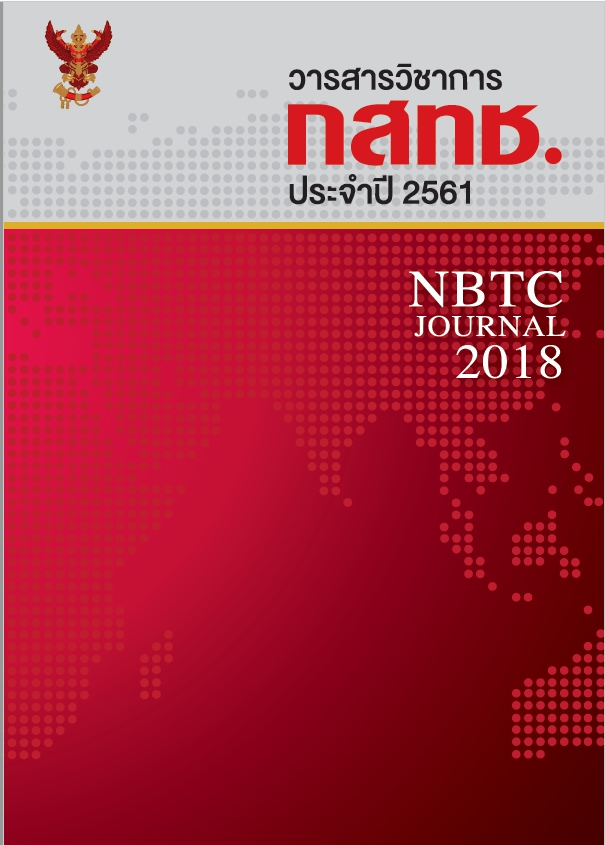Spectrum Cap and Mobile Operators' Performance: Thailand’s experience
Keywords:
Spectrum cap, Mobile operators’ performance, ThailandAbstract
Spectrum auction has been accepted as an efficient tool for allocating the radio spectrum and increasing competition level among service providers in the telecommunication market. Most of National Regulatory Authorities (NRAs) use spectrum cap as an incentive instrument to facilitate new entrants and to reduce a chance of natural monopoly in acquiring spectrum. These two different regulatory instruments seem to provide contradictory results. On one hand spectrum auction should allow Mobile Network Operator (MNO) to obtain as much as spectrum bandwidth. It may lead to one MNO may gain most of spectrum bandwidth in the market or being a dominant player in the market. On another, spectrum cap limits amount of bandwidths where the MNO could obtain. It aims to provide an opportunity to smaller and/or new comer operator to gain spectrum bandwidths as well as its competitive advantage. The National Broadcasting and Telecommunications Commission (NBTC) has followed the practices from other NRAs by implementing spectrum auctions together with setting spectrum cap for each bidder in an event of auction. This paper aims to investigate impact on firms’ performance, i.e. data share to spectrum share ratio, subscriber share to spectrum share ratio, etc., in Thailand. The findings show that 40% sub-1GHz cap produces a better output in term of spectrum efficiency. It is somehow contrast with other studies. However, this may result from a long term implementation of spectrum cap. Mobile operator needs to prepare itself to handle the limitation of spectrum.
References
Cave, M. (2009). Anti-Competitive Behaviour in Spectrum Markets. TPRC Conference.
Cave, M., and Webb, W. (2013). Spectrum Limits and Auction Revenue: the European. Sprint Corporation.
Cramton, P. (2001). Spectrum Auctions. (M. Cave, S. Majumdar, & I. Vogelsanf, Eds.) Handbook of
Telecommunications Economics.
Cramton, P. (2013). The Rationale for Spectrum Limits and Their Impact on Auction Outcomes FCC. Retrieved June
, 2018 from https://ecfsapi.fcc.gov/file/7520942733.pdf
Cramton, P., Kwerel, E., Rosston, G., and Skrzypacz, A. (2011). Using Spectrum Auction to Enhance Competition in
Wireless Services. The Journal of Law and Economics, 54.
Earle, R., and Sosa, D. (2013) Spectrum Auctions Around the World: An Assessment of International Experiences
with Auction Restrictions. Retrieve June 1, 2018 from https://mobilefuture.org/wp
content/uploads/2013/07/Spectrum-Auctions-Around-The-World.pdf
Mobile Europe (2017). Ofcom imposes spectrum cap on UK market, leaves Three fuming. Retrieve June 1, 2018 from
Nichiforov-Chuang, D. (2015). Spectrum for new entrants, lessons learned. Retrieved June 1, 2018 from
https://www.gsmaintelligence.com/research/?file=3f4ec58d593cdd88d2a7e71995e82733&download
Ofcom. (2017). Award of the 2.3 and 3.4 GHz spectrum bands: Competition issues and auction regulations.
Retrieved June 1, 2018 from https://www.ofcom.org.uk/__data/assets/pdf_file /0022/103819/Statement-Award-
of-the-2.3-and-3.4-GHz-spectrum-bands-Competition-issues-and-auction-regulations.pdf
Philipose, M. (2017). TRAI recommended spectrum caps will accommodate emerging oligopoly [Online Article]
Retrieved June 1, 2018 from https://www.livemint.com/Money/fbHwcbsSuMGEL1FwJKDV3K/Trai-recommended-
spectrum-caps-will-accommodate-emerging-oli.html
Sambandaraksa, D. (2012). NBTC cut spectrum cap to prevent duopoly [Online article) Retrieved June 1, 2018,
from https://www.telecomasia.net/content/nbtc-cut-spectrum-cap-prevent-duopoly
Srinuan, C., Srinuan, P. and Bohlin, E. (2012), “An analysis of mobile Internet access in Thailand: Implications for
bridging the digital divide”, Telematics and Informatics, 29 (3), 254-262.
Srinuan,P. Annafari, M.A and Bohlin,E. (2011), “ An analysis of switching behavior in the Thai cellular market”,
Info, 13(4), 61-74.
Srinuan, P., Madden, G., Bohlin, E., and Srinuan, C. (2013). An analysis of mobile number portability effects on
customer switching behavior in Thai mobile service. ITS Perth Conference
Downloads
Published
How to Cite
Issue
Section
License
The Office of the NBTC holds the copyright of articles appearing in the journal. The Office of the NBTC allows the public or individuals to distribute, copy, or republish the work under a Creative Commons license (CC), with attribution (BY), No Derivatives (ND) and NonCommercial (NC); unless written permission is received from the Office of the NBTC.
Text, tables, and figures that appear in articles accepted for publication in this journal are personal opinion and responsibility of the author, and not binding on the NBTC and the Office of the NBTC. In case of errors, each author is solely responsible for their own article, and not concerning the NBTC and the NBTC Office in any way.



